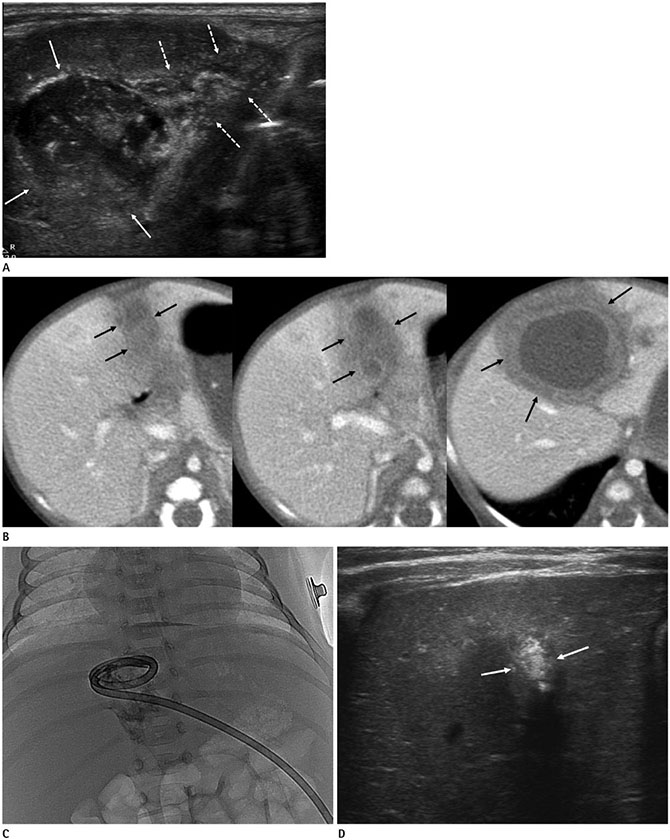J Korean Soc Radiol.
2018 Nov;79(5):271-275. 10.3348/jksr.2018.79.5.271.
Minimally Invasive Treatment of Falciform Ligament Abscess in a 25-Day-Old Neonate: A Case Report
- Affiliations
-
- 1Department of Radiology, Jeju National University Hospital, Jeju National University School of Medicine, Jeju, Korea. shinshlee@naver.com
- 2Department of Pediatrics, Jeju National University Hospital, Jeju National University School of Medicine, Jeju, Korea.
- KMID: 2422904
- DOI: http://doi.org/10.3348/jksr.2018.79.5.271
Abstract
- The falciform ligament is a hepatic suspensory ligament that extends from the umbilicus to the diaphragm, containing the ligamentum teres and a vestigial remnant of the umbilical vein. Among the rarely-occurring pathologies of the falciform ligament, which include ligament cyst, tumor, abnormal vascularization, and congenital ligament defect, a falciform ligament abscess is even more sporadic. Accordingly, the definitive diagnosis of the falciform ligament abscess is rather challenging and may easily be misinterpreted as an infected choledochal cyst or a liver abscess. We present a 25-day-old infant with the falciform ligament abscess, which developed after the umbilical venous catheter insertion and was successfully treated with percutaneous drainage and antibiotic administration.
MeSH Terms
Figure
Reference
-
1. Kim S, Kim TU, Lee JW, Lee TH, Lee SH, Jeon TY, et al. The perihepatic space: comprehensive anatomy and CT features of pathologic conditions. Radiographics. 2007; 27:129–143.
Article2. Sharma M, Rai P, Rameshbabu CS, Senadhipan B. Imaging of peritoneal ligaments by endoscopic ultrasound (with videos). Endosc Ultrasound. 2015; 4:15–27.
Article3. Moon SB, Lee HW, Park KW, Jung SE. Falciform ligament abscess after omphalitis: report of a case. J Korean Med Sci. 2010; 25:1090–1092.
Article4. Lipinski JK, Vega JM, Cywes S, Cremin BJ. Falciform ligament abscess in the infant. J Pediatr Surg. 1985; 20:556–558.
Article5. Hillman BJ, D'Orsi CJ, Smith EH, Bartrum RJ. Ultrasonic appearance of the falciform ligament. AJR Am J Roentgenol. 1979; 132:205–206.
Article6. Ozkececi ZT, Ozsoy M, Celep B, Bal A, Polat C. A rare cause of acute abdomen: an isolated falciform ligament necrosis. Case Rep Emerg Med. 2014; 2014:570751.7. Sones PJ Jr, Thomas BM, Masand PP. Falciform ligament abscess: appearance on computed tomography and sonography. AJR Am J Roentgenol. 1981; 137:161–162.
Article8. Pratap A, Tiwari A, Anchal N, Agrawal CS, Shreshta P, Shakya VC. Falciform ligament abscess with portal pyemia in a newborn. J Pediatr Surg. 2006; 41:1473–1475.
Article9. Sawardekar KP. Changing spectrum of neonatal omphalitis. Pediatr Infect Dis J. 2004; 23:22–26.
Article
- Full Text Links
- Actions
-
Cited
- CITED
-
- Close
- Share
- Similar articles
-
- Abscess Formation Involving the Falciform Ligament and Ligamentum Teres
- Primary Abscess of the Falciform Ligament
- Falciform Ligament Abscess after Omphalitis: Report of a Case
- Torsion of Fatty Appendage of Falciform Ligament Following Endoscopic Retrograde Cholangiopancreatography
- Double Cystic Artery Originating in a Right and a Segment IV Hepatic Artery: A Case Report


